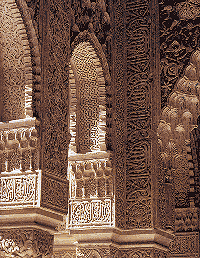Math of the Moors
By Murray Bourne, 07 Feb 2007
In 711 AD, barely 100 years after the establishment of Islam, the Moors crossed over from Northern Africa and conquered most of Spain. Many of the anti-Catholic Christians and Jews resident in Spain did not see the invasion as a totally Bad Thing, since the Moors showed religious tolerance - more than the Catholics did - and made many improvements.

The Alhambra
The Moors brought with them a richness of culture and learning that was sorely missing from Medieval Christian society. Arriving with translations of the Greek masters (Archimedes, Pythagoras and the philosopher Ptolemy), the Moors established robust institutions of learning, including well-stocked libraries. They set about improving agriculture, astronomy, architecture, science and mathematics. They called their new land Al-Andalus.
The locals were still using the Roman numeral system (I, II, III, IV, ...), but the Moors introduced a much better system of numbers (derived from India via the middle east and Alexandria), called the Hindu-Arabic number system.
Hindu Arabic numbers
The big deal about the new number system was that it was positional. This means that for a large number containing several digits, the further to the left you go, the larger the value of the digit. Each position to the left represents a multiple of 10.
For example, four thousand, three hundred and sixty five in the new system was written 4,365 and the value of the digits means:
1000 | 100 | 10 | 1 4 | 3 | 6 | 5
The same number in Roman numerals was written MMMMCCCLXV (4 × 1000 + 3 × 100 + 50 + 10 + 5). It was quite difficult to perform calculations with such a cumbersome system.
Here's what Hindu-Arabic numerals looked like by about 1000 AD. We can see that they resemble closely the numbers we use today.

A Violent End
The Moors were advanced technically and had established a very enlightened society for the time. Unfortunately, they were too complacent about their enemies and they let their guard down. Eventually the Catholics attacked from the north and took over the whole of Spain by 1492. This was after they terrorised the Moors for hundreds of years by requiring conversion to Catholicism or face expulsion. The ones who were found to be not "Catholic enough" were sent off for torture in the Inquisition. Eventually, the remaining few hundred thousand were ethnically cleansed and sent packing to North Africa or beyond. It was a tragic end to an inspiring flowering of learning and discovery.
In fact, the Moors had a large influence on the beginning of the Renaissance (around 1450) in other parts of Europe. The universities of Paris and Oxford were established as a result of visits by scholars to Al-Andalus.
Contributions of the Moors
We get many mathematical concepts (and words) from (or via) the Moors, including:
- algebra
- algorithm
- zero (from "zephirum")
End Bit
It is a tragedy that these people who contributed so much were snuffed out. The Spanish have chosen to ignore many of the details of this episode from their history. The winners will always get to interpret history how they like.
The Moors deserve more credit.
Update: The invention of the antennae in this Fractal Tiling Arrays article was inspired by the intricate tiling of the Alhambra mosque.
Comments are off for this post.
